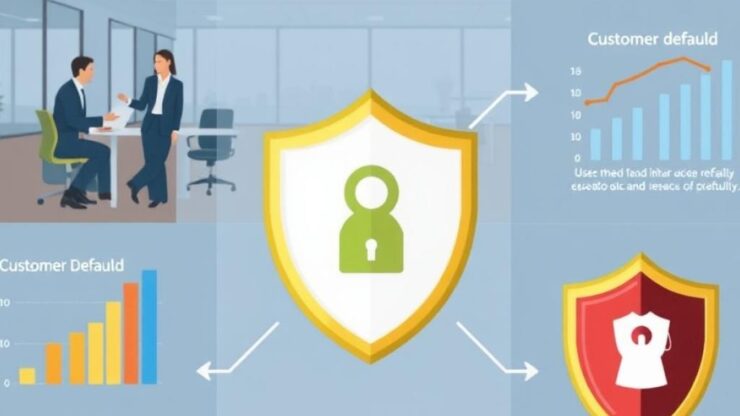Understanding Credit Insurance
What is Credit Insurance?
Credit insurance is a financial tool that protects businesses from the risk of customer defaults. It serves as a safety net, ensuring that companies can manage their accounts receivable without the constant fear of non-payment. By transferring the risk of default to an insurer, businesses can focus on growth and expansion, knowing they have a safeguard against unforeseen circumstances.
The Mechanism Behind Credit Insurance
Understanding how credit insurance works is essential for businesses considering this protective measure. When a company purchases credit insurance, it pays a premium to an insurer in exchange for coverage against losses resulting from customer defaults. The insurer evaluates the creditworthiness of the policyholder’s customers and provides coverage based on the assessed risk. This process not only offers peace of mind but also enhances a business’s ability to extend credit to new or existing customers.
Benefits of Credit Insurance
Credit insurance comes with a myriad of advantages that can significantly impact a business’s financial stability and growth potential. Below is a comprehensive list of the benefits that credit insurance offers:
- Risk Mitigation: Protects against non-payment and reduces financial loss.
- Improved Cash Flow: Ensures timely payments, stabilizing cash flow.
- Enhanced Credit Management: Provides access to valuable credit assessment tools.
- Increased Sales Opportunities: Encourages businesses to extend credit to new customers without fear.
- Financial Stability: Supports loan applications by showcasing reduced risk.
In conclusion, credit insurance serves as a vital resource for businesses looking to safeguard their financial health against customer defaults. By understanding its mechanisms and benefits, companies can make informed decisions that enhance their resilience and foster growth.
Benefits of Credit Insurance for Businesses
In a rapidly changing economic landscape, businesses must adopt strategic measures to mitigate risks associated with customer defaults. Credit insurance emerges as a powerful ally, offering a suite of advantages that extend far beyond mere protection against non-payment. By integrating this financial tool into their risk management strategy, companies unlock a pathway to enhanced stability and growth.
One of the most significant benefits of credit insurance is its ability to enhance cash flow management. When businesses are assured that their receivables are protected, they can operate with increased confidence. This assurance translates into improved liquidity, allowing companies to reinvest in operations, fulfill orders promptly, and maintain a healthy cash flow cycle. Such stability is crucial for businesses looking to seize market opportunities without the burden of fear stemming from potential defaults.
Moreover, credit insurance equips businesses with advanced credit management tools. Insurers conduct extensive evaluations of customer creditworthiness, providing policyholders with insights that can guide their credit decisions. This data-driven approach not only reduces the likelihood of extending credit to high-risk clients but also empowers businesses to make informed decisions, thereby optimizing their credit portfolios.
The ability to extend credit confidently to new customers is another vital advantage of credit insurance. Businesses often find themselves hesitant to engage with potential clients due to the associated risks of non-payment. However, with credit insurance in place, companies can broaden their customer base without the anxiety of financial loss. This willingness to extend credit not only fosters customer loyalty but also drives sales growth, allowing businesses to capture new markets and expand their reach.
Furthermore, credit insurance plays a pivotal role in enhancing a company’s creditworthiness in the eyes of lenders and investors. When businesses demonstrate that they have safeguards against customer defaults, it signals financial prudence and reduces perceived risk. This improved financial profile can lead to better terms when securing loans or attracting investment, ultimately supporting long-term growth objectives.
In summary, the multifaceted benefits of credit insurance significantly contribute to a business’s resilience. By providing robust protection against customer defaults, facilitating better cash flow, and empowering growth through informed credit decisions, credit insurance stands as a cornerstone in modern business strategy.
Types of Credit Insurance Policies
As businesses navigate the complexities of customer relationships and financial obligations, the availability of various credit insurance policies allows them to tailor protection to their specific needs. Understanding the different types of credit insurance can empower companies to make informed decisions that align with their risk management strategies. Here, we delve into the primary types of credit insurance policies available in the market today.
Trade Credit Insurance
This is the most prevalent form of credit insurance. Trade credit insurance protects businesses against the risk of non-payment by their customers for goods or services rendered. In essence, it provides coverage for accounts receivable, enabling companies to extend credit to their customers with confidence. This type of insurance is essential for businesses that operate on credit terms, as it mitigates the risk of financial loss from customer defaults.
Consumer Credit Insurance
Consumer credit insurance is designed primarily for businesses that offer financing options directly to consumers. This policy protects against the risk of non-payment due to various factors, such as unemployment, illness, or death. It is particularly valuable for companies in industries such as retail, where financing options can significantly boost sales. By offering consumer credit insurance, businesses can enhance customer trust while minimizing the impact of defaults on their bottom line.
Political Risk Insurance
For businesses engaged in international trade, political risk insurance provides protection against losses resulting from political events. These events may include war, expropriation, or changes in government policies that affect the ability of customers to pay. This type of insurance is crucial for companies that operate in volatile regions, allowing them to expand their reach while managing potential political risks effectively.
To summarize the distinctions between these types of credit insurance policies, refer to the table below:
| Type of Credit Insurance | Coverage Focus | Ideal For |
|---|---|---|
| Trade Credit Insurance | Non-payment by business customers | Businesses offering trade credit |
| Consumer Credit Insurance | Non-payment due to consumer issues | Retailers and service providers |
| Political Risk Insurance | Losses due to political events | International businesses |
By recognizing the unique attributes of each credit insurance policy, businesses can better position themselves to safeguard their financial health against customer defaults. Whether engaging in domestic trade or navigating international markets, selecting the appropriate type of credit insurance is a critical step in enhancing resilience and fostering growth.
Assessing Risk and Coverage Needs
In the dynamic landscape of business, safeguarding against customer defaults has become a cornerstone of financial strategy. For companies considering credit insurance, a crucial step lies in assessing risk and understanding coverage needs. This process not only involves evaluating the financial health of potential customers but also encompasses a comprehensive analysis of the overall market environment. By taking a thorough approach, businesses can tailor their credit insurance policies to effectively mitigate risks while maximizing their growth potential.
Evaluating Customer Creditworthiness is paramount in the process of assessing risk. Businesses must conduct exhaustive research into the credit profiles of their customers, including payment histories, financial statements, and industry performance. Insurers often provide valuable tools and analytics that can assist in this evaluation, allowing companies to gain insights that inform their decision-making. By understanding the creditworthiness of their customer base, businesses can establish appropriate credit limits and determine whether to extend credit under specific terms. This proactive approach not only reduces the risk of defaults but also fosters a more resilient business model.
Furthermore, analyzing Industry Trends plays a significant role in determining coverage needs. Different sectors face unique challenges and risks that can influence payment behaviors. For instance, industries experiencing rapid growth may encounter delays in payment as businesses scale operations. Conversely, sectors undergoing economic downturns may witness heightened default rates. By staying informed about industry dynamics, businesses can adjust their credit insurance coverage accordingly, ensuring they are adequately protected against sector-specific risks. This alignment between coverage and business environment is critical for long-term sustainability.
Lastly, collaboration with Insurance Professionals cannot be overstated in the journey of assessing risk and determining coverage needs. Engaging with experienced credit insurance brokers or providers can unlock tailored solutions that reflect the unique challenges faced by a business. These professionals bring a wealth of knowledge, offering insights into market conditions and helping businesses navigate the complexities of policy options. By leveraging their expertise, companies can craft a credit insurance strategy that not only protects against customer defaults but also aligns with their broader financial goals.
Claim Process and Policy Management
The implementation of credit insurance is a significant step toward securing a business’s financial future. However, understanding the intricacies of the claim process and managing policies effectively is equally essential. An effective claim process ensures that businesses can recover losses promptly, while proficient policy management allows for adapting to changing market conditions and customer dynamics. This section delves into both aspects, offering insights that empower businesses to maximize the benefits of their credit insurance coverage.
Mastering the Claim Process
When a customer defaults, the claim process becomes the lifeline for businesses relying on credit insurance. To initiate a claim, the insured party must first gather all pertinent documentation, including invoices, proof of delivery, and any communications regarding payment terms. This compilation of evidence is crucial, as it strengthens the legitimacy of the claim and facilitates a smoother resolution. Once all necessary papers are in order, the business must notify the insurer promptly. Timeliness is key; most policies require claims to be filed within a specific period after the default is recognized.
After submission, insurers typically conduct a thorough investigation, which may involve verifying the defaulting customer’s financial status and the circumstances surrounding the non-payment. This phase can vary in duration, but maintaining clear communication with the insurer is vital for expediting the process. Furthermore, businesses should be prepared for potential negotiations regarding the claim amount, as insurers may assess the extent of losses differently. Understanding the nuances of this process can significantly impact the recovery timeline and the amount received.
Strategic Policy Management for Sustainable Growth
Effective management of credit insurance policies is not a one-time task but an ongoing commitment that can significantly influence a company’s resilience. Regularly reviewing policy terms and coverage limits is essential, especially as businesses evolve and market conditions fluctuate. It’s advisable for companies to engage in periodic discussions with their insurance providers to ensure that their coverage aligns with their current risk exposure and operational scale.
Additionally, businesses should take advantage of the insights and analytics provided by insurers regarding customer creditworthiness. By actively leveraging this information, companies can refine their credit policies and extend credit more strategically. This proactive approach not only enhances credit management but also minimizes the risk of facing defaults in the first place. Ultimately, a well-managed credit insurance policy serves as a robust foundation for a business’s financial strategy, supporting growth and stability in a volatile economic environment.
Disclaimer
This article has been created or edited with the support of artificial intelligence and is for informational purposes only. The information provided should not be considered investment advice. Please seek the support of a professional advisor before making any investment decisions.






